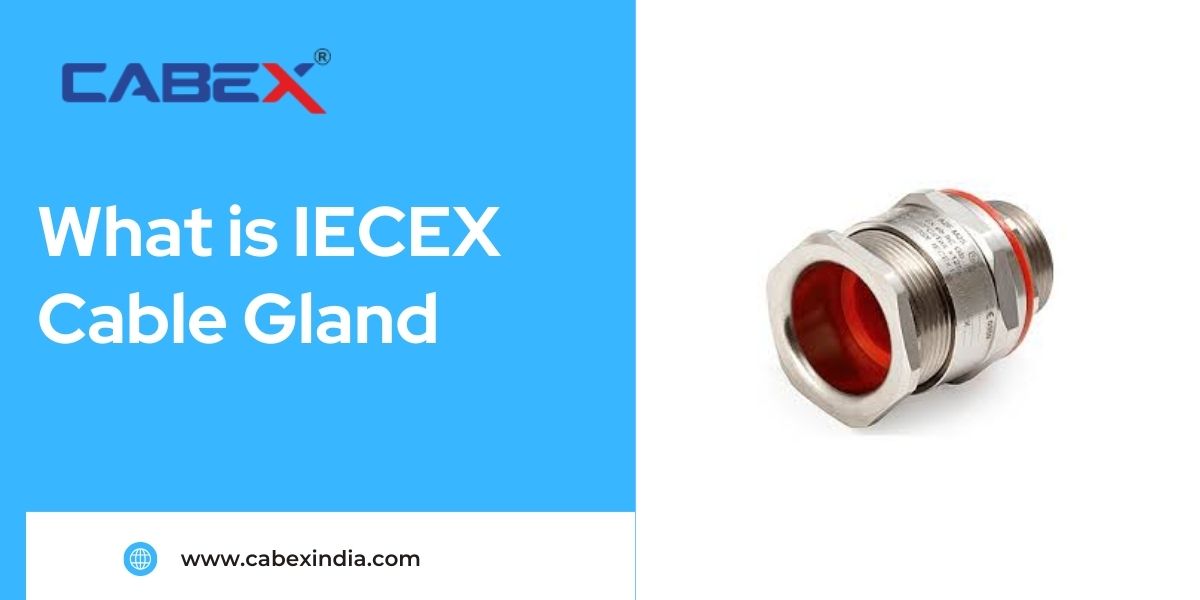IECEX Cable Gland: In the realm of industrial electrical installations, safety and reliability are paramount. One vital component that plays a significant role in achieving these objectives. This unassuming yet essential device is the linchpin of cable integrity and safety in areas where explosive atmospheres are a constant concern. In this comprehensive guide, we will delve into the intricacies of IECEX Cable Glands, exploring their purpose, construction, standards, and applications.
Understanding the Basics
What is an IECEX Cable Gland?
An IECEX Cable Gland is a specialized piece of equipment designed to securely attach and seal cables entering or exiting an enclosure, ensuring the integrity of the enclosure’s ingress protection. Its primary function is to prevent the passage of dust, liquids, or gases and maintain the integrity of the electrical installation. What sets IECEX Cable Glands apart is their suitability for use in hazardous areas where explosive atmospheres pose a constant threat.
The Significance of Hazardous Areas
Before we delve deeper into the specifics of IECEX Cable Glands, it’s essential to understand why they are crucial. Hazardous areas are environments where the presence of flammable gases, vapors, dust, or fibers can lead to the ignition of explosive mixtures. These areas are categorized into zones, depending on the likelihood and duration of the hazardous atmosphere.
The Anatomy of an IECEX Cable Gland
IECEX Cable Glands may appear simple, but their design is far from it. To appreciate their effectiveness and the standards they adhere to, let’s break down their components:
- Cable Entry: The cable is introduced into the enclosure through the cable entry portion of the gland. It provides mechanical support to the cable, ensuring it remains firmly in place.
- Sealing Elements: These are crucial for maintaining the ingress protection rating of the enclosure. The sealing elements prevent the passage of gases, liquids, or dust and come in various forms, including compression seals and elastomeric seals.
- Body: The body of the IECEX Cable Gland is typically made of metal or plastic and serves as the main structural component. It houses the sealing elements and secures the cable.
- Locknut: The locknut is used to secure the gland to the enclosure. It’s crucial for maintaining the integrity of the seal.
- Thread: The thread of the IECEX Cable Gland allows it to be attached to the enclosure, creating a secure and sealed connection.
- Outer Gasket: Some IECEX Cable Glands have an additional outer gasket to enhance the sealing against ingress.
IECEX Standards – Ensuring Safety and Compliance
To ensure the safety and reliability of IECEX Cable Glands, they must adhere to stringent international standards. The International Electrotechnical Commission (IEC) governs these standards, and the IECEx Certification Scheme ensures compliance. Key standards that govern IECEX Cable Glands include:
1. IEC 60079 Series
The IEC 60079 series of standards deals with equipment used in explosive atmospheres. It provides the framework for the design, construction, testing, and certification of equipment, including Cable Glands. The specific standard that deals with cable glands is IEC 60079-14, which outlines the requirements for the selection, installation, and maintenance of electrical installations in hazardous areas.
2. IECEx Certification Scheme
IECEX Cable Glands that bear the IECEx mark are internationally recognized as complying with these rigorous standards. The IECEx Certification Scheme, established to facilitate international trade in equipment for use in explosive atmospheres, ensures that products are manufactured to meet safety and performance criteria.
Application Areas
IECEX Cable Glands find applications in a wide range of industries and scenarios where safety and reliability are paramount. Some common areas where these specialized cable glands are indispensable include:
1. Oil and Gas Industry
In oil and gas facilities, explosive atmospheres are a constant concern. IECEX Cable Glands are used extensively to seal and secure cables in these environments, preventing the ingress of flammable gases and minimizing the risk of explosions.
2. Chemical Industry
Chemical plants often deal with volatile substances. IECEX Cable Glands play a crucial role in maintaining the integrity of electrical connections in areas where explosive atmospheres may occur.
3. Mining Operations
Mines can harbor explosive gases and dust. IECEX Cable Glands are vital in ensuring the safety and reliability of electrical connections in such conditions.
4. Pharmaceutical Industry
In pharmaceutical manufacturing, where precision and safety are critical, IECEX Cable Glands are used to protect electrical connections in potentially hazardous areas.
5. Manufacturing and Processing Plants
Many manufacturing and processing plants deal with flammable materials. IECEX Cable Glands provide the necessary protection against explosive atmospheres.
6. Wastewater Treatment Plants
Wastewater treatment facilities often handle corrosive substances, making it essential to use IECEX Cable Glands to maintain the integrity of electrical connections.
Installation and Maintenance
Proper installation and regular maintenance of IECEX Cable Glands are crucial for their effectiveness and longevity. Here are some key considerations:
Installation:
- Cable Selection: Choose the appropriate cable for the environment, ensuring it’s compatible with the Cable Gland.
- Thread Compatibility: Ensure that the thread of the Cable Gland matches that of the enclosure for a proper fit.
- Sealing Elements: Check the condition of the sealing elements and ensure they are correctly placed.
- Torque: Tighten the locknut to the manufacturer’s recommended torque to achieve the proper seal.
Maintenance:
- Regular Inspection: Periodically inspect the Cable Gland and the cable for any signs of damage or wear.
- Re-Torquing: If there is any sign of loosening, re-torque the locknut to maintain the seal’s integrity.
- Replacement of Sealing Elements: If the sealing elements are damaged or worn, replace them promptly to maintain the level of protection.
Varieties of IECEX Cable Glands
IECEX Cable Glands are available in various types to cater to different applications and cable types. Here are some common varieties:
1. Armored Cable Glands
Designed for use with cables that have metal armor, these Cable Glands provide additional mechanical protection.
2. Non-Armored Cable Glands
Suitable for cables without metal armor, these Glands are designed to create a seal around the cable’s outer sheath.
3. EMC Cable Glands
For applications where electromagnetic compatibility (EMC) is essential, these Cable Glands provide protection against electromagnetic interference.
4. Ex e Glands
These Glands are designed for increased safety in hazardous areas. They create a barrier against the passage of explosive gases.
5. Ex d Glands
Explosion-proof Cable Glands, often referred to as Ex d Glands, are designed to contain an explosion within the enclosure, preventing it from propagating to the surrounding area.
Conclusion
IECEX Cable Glands may be small components in the grand scheme of industrial electrical installations, but their significance cannot be overstated. They form a critical line of defense against the potentially catastrophic consequences of explosive atmospheres in various industries. Through meticulous design, adherence to international standards, and careful installation and maintenance, these Cable Glands contribute to the safety and reliability of electrical connections in the most hazardous of environments.
FAQ
Q1: What is the primary purpose of an IECEX cable gland in an industrial setting?
Ans: The primary purpose of an IECEX cable gland in an industrial setting is to ensure the safe and secure entry of electrical cables into equipment or enclosures in hazardous environments.
Q2 : What distinguishes an IECEX cable gland from standard cable glands?
Ans: An IECEX cable gland is distinguished by its compliance with the International Electrotechnical Commission’s (IEC) standards, particularly those related to explosive atmospheres.
Q3 : In what industries are IECEX cable glands commonly utilized, and why?
Ans: IECEX cable glands find common application in industries where explosive atmospheres pose a significant risk. This includes but is not limited to:
1. Oil and Gas: Due to the presence of flammable hydrocarbons.
2. Chemical Processing: Where corrosive substances are handled.
3. Mining: Particularly in underground environments with combustible dust and gases.






